Rupert Matthews's Blog, page 24
March 26, 2014
Engladn vs Scotland - the Early Years
Engladn vs Scotland - the Early Years
The island of Britain contains two kingdoms: England and Scotland. Wales is, strictly speaking, a princpality and Cornwall a Duchy.
Over the years the two kingdoms have been rivals, allies, friends and enemies. In the very earliest days, both the Scots and the English were foreigners to Britain. The Scots were an Irish tribe settled in the lands around Kintyre while the English were invaders from northern Germany.
As Roman control over the province of Britain collapsed in the 5th century the English and the Scots both expanded their power and their territories. It was inevitable that they would eventually clash and battle was joined at Degsaston in about the year 603. At the time neither the English nor the Scots were a unified people and some years later the northern English fought against the Picts at Nechtansmere. The climax of these early battles came at Brunanburh, possibly the most decisive battle ever fought in Britain.
The truth about these early battles can be difficult to trace in any detail. The chroniclers often blurred events and places and were hopelessly inaccurate when dealing with figures. It is sometimes impossible to know exactly where the battle was fought and what happened. The author has walked the likely sites of the battles and closely studied the contemporary accounts. He is confident that he has been able to recreate what happened.
By the time of the Battle of the Standard the Scots and English had left the Dark Ages behind them and had become unified states in name, if not always in fact. The Kings of England claimed a vague superiority over the Kings of Scots, though it was never entirely clear what this meant. For the next four centuries the relationship between the two nations led to the battlefield as often as to the marriage altar or the negotiating table.
from England Vs Scotland by Rupert Matthews.
Get your copy HERE
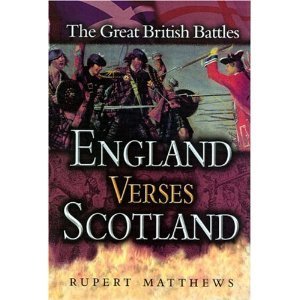
http://www.amazon.co.uk/England-Versu...

The island of Britain contains two kingdoms: England and Scotland. Wales is, strictly speaking, a princpality and Cornwall a Duchy.
Over the years the two kingdoms have been rivals, allies, friends and enemies. In the very earliest days, both the Scots and the English were foreigners to Britain. The Scots were an Irish tribe settled in the lands around Kintyre while the English were invaders from northern Germany.
As Roman control over the province of Britain collapsed in the 5th century the English and the Scots both expanded their power and their territories. It was inevitable that they would eventually clash and battle was joined at Degsaston in about the year 603. At the time neither the English nor the Scots were a unified people and some years later the northern English fought against the Picts at Nechtansmere. The climax of these early battles came at Brunanburh, possibly the most decisive battle ever fought in Britain.
The truth about these early battles can be difficult to trace in any detail. The chroniclers often blurred events and places and were hopelessly inaccurate when dealing with figures. It is sometimes impossible to know exactly where the battle was fought and what happened. The author has walked the likely sites of the battles and closely studied the contemporary accounts. He is confident that he has been able to recreate what happened.
By the time of the Battle of the Standard the Scots and English had left the Dark Ages behind them and had become unified states in name, if not always in fact. The Kings of England claimed a vague superiority over the Kings of Scots, though it was never entirely clear what this meant. For the next four centuries the relationship between the two nations led to the battlefield as often as to the marriage altar or the negotiating table.
from England Vs Scotland by Rupert Matthews.
Get your copy HERE

http://www.amazon.co.uk/England-Versu...

Published on March 26, 2014 02:06
March 10, 2014
What was at stake at Thermopylae in 480BC
What was at stake at Thermopylae in 480BC
This book is the story of perhaps the most famous military campaign of the ancient world. It has everything that a writer could want: action, adventure, mystery and much more. As a story, it is thrilling. As an exercise in military history it is fascinating.
The Greeks later claimed that the entire future history of the world hinged on this one campaign. As they saw things, the vast and powerful Persian Empire was a brutal dictatorship in which nobody had any rights except by favour of the monarch – the King of Kings or Great King. All individuality was stamped out by the autocratic system which stifled trade, the arts and freedom. In the Greek city states, the arts and sciences flourished as individual freedom was celebrated and allowed its full rein. Each of the many small states was free to choose its own system of government. This Thermopylae campaign was a war between the Free World and a Slave World.
That, at least, is how the Greeks saw it. It was an apocalyptic vision in which the stakes were high and the world trembled on the edge of an abyss. Many modern writers have followed the Greek lead and viewed the wars of which the Thermopylae Campaign formed a part as being a struggle for freedom.
As ever, of course, things were not quite that simple. Slavery was an accepted part of life in all Greek states: the much vaunted freedoms were reserved for the privileged citizens. Nor was the Persian system of government quite as brutal as the Greeks liked to maintain. Subject peoples were often allowed to run their own affairs according to their own laws, so long as they paid their taxes on time and caused no trouble. And the war was very definitely not a conflict between Greeks and Persians. Many Greek states were already within the Persian Empire, or owed allegiance to it, and their men fought on the “Persian” side in the conflict. Many other Greek states, cowed by the awesome might of the King of Kings surrendered promptly rather than fight.
But in many ways the old, Greek view of this conflict does hold true. The issues may not have been as black and white as they pretended, but this was very definitely a war between rival and incompatible cultures. It was a war in which there could be no compromise peace or diplomatic fudge. Either Persia would conquer Greece or it would not.
From THE BATTLE OF THERMOPYLAE by Rupert Matthews

This book is the story of perhaps the most famous military campaign of the ancient world. It has everything that a writer could want: action, adventure, mystery and much more. As a story, it is thrilling. As an exercise in military history it is fascinating.
The Greeks later claimed that the entire future history of the world hinged on this one campaign. As they saw things, the vast and powerful Persian Empire was a brutal dictatorship in which nobody had any rights except by favour of the monarch – the King of Kings or Great King. All individuality was stamped out by the autocratic system which stifled trade, the arts and freedom. In the Greek city states, the arts and sciences flourished as individual freedom was celebrated and allowed its full rein. Each of the many small states was free to choose its own system of government. This Thermopylae campaign was a war between the Free World and a Slave World.
That, at least, is how the Greeks saw it. It was an apocalyptic vision in which the stakes were high and the world trembled on the edge of an abyss. Many modern writers have followed the Greek lead and viewed the wars of which the Thermopylae Campaign formed a part as being a struggle for freedom.
As ever, of course, things were not quite that simple. Slavery was an accepted part of life in all Greek states: the much vaunted freedoms were reserved for the privileged citizens. Nor was the Persian system of government quite as brutal as the Greeks liked to maintain. Subject peoples were often allowed to run their own affairs according to their own laws, so long as they paid their taxes on time and caused no trouble. And the war was very definitely not a conflict between Greeks and Persians. Many Greek states were already within the Persian Empire, or owed allegiance to it, and their men fought on the “Persian” side in the conflict. Many other Greek states, cowed by the awesome might of the King of Kings surrendered promptly rather than fight.
But in many ways the old, Greek view of this conflict does hold true. The issues may not have been as black and white as they pretended, but this was very definitely a war between rival and incompatible cultures. It was a war in which there could be no compromise peace or diplomatic fudge. Either Persia would conquer Greece or it would not.
From THE BATTLE OF THERMOPYLAE by Rupert Matthews

Published on March 10, 2014 03:07
February 26, 2014
"Ask Diego Flores" - The Spanish Armada
"Ask Diego Flores" - The Spanish Armada
Howard began to manoeuvre his fleet as if he meant to attack, though in truth he was bluffing and hoping to hustle the Spanish fleet toward the shoals. The threat was taken seriously by Medina Sidonia who signalled for any ships still able to fight to come to join him. Pataches and boats were sent out to go around the rest of the Armada with the advice that they were “to keep their heads close to the wind as they were almost on the Zeeland shoals”. The advice must have been superfluous for every captain could see the surf for himself. More than one captain must have cursed the duke for his pointless advice and for getting them into this deathtrap in the first place.
Meanwhile the warships still able to get into the wind were closing on the flagship. Recalde was there, as ever, and so was de Leyva. The three surviving galleasses came up with their oars thrashing the water. A few other warships bore up, though they were all desperately short of ammunition. It seems that Medina Sidonia asked hoped to delay the coming English attack on his more vulnerable ships.
Then up came the great Santa Ana, flagship of the Squadron of Guipuzcoa, with the admiral Miguel de Oquendo on board. This ship came with hailing distance of the San Martin and the figure of Oquendo was clearly visible on the sterncastle. Medina grabbed a speaking trumpet and bellowed across the waves to his subordinate admiral.
“Senor Oquendo, what shall we do?” demanded the hapless commander.
“Ask Diego Flores,” snarled back Oquendo his anger boiling over. “As for me, I am going to fight the English and die like a man. Give me your shot.”
It was an extraordinary and calculated insult. That a man, even a fighting admiral as experienced as Oquendo, could feel able to talk to his commanding officer and a premier grandee of Spain in such a fashion was astonishing and showed the feelings in the Armada. That he should blame Diego Flores, Medina Sidonia’s naval adviser, for the mess was natural enough. Few of the naval commanders had forgiven Diego Flores for persuading Medina Sidonia to abandon the crippled ships - the Rosario and San Salvador - earlier in the campaign. But his furious insult to Medina Sidonia himself was unparalleled. By asking for the flagship’s cannonballs, Oquendo was openly implying that Medina Sidonia would not need them himself as he was too cowardly to fight the English.
Of all the events in the Armada campaign this brief exchange was surely the most amazing.
Medina Sidonia was speechless. He put down the speaking trumpet and turned away to return to his cabin. There was not much else he could do.
from THE SPANISH ARMADA by Rupert Matthews
Get your copy here
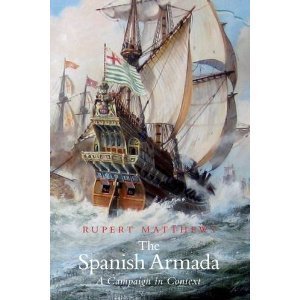
http://www.amazon.co.uk/%2522The-Span...

Howard began to manoeuvre his fleet as if he meant to attack, though in truth he was bluffing and hoping to hustle the Spanish fleet toward the shoals. The threat was taken seriously by Medina Sidonia who signalled for any ships still able to fight to come to join him. Pataches and boats were sent out to go around the rest of the Armada with the advice that they were “to keep their heads close to the wind as they were almost on the Zeeland shoals”. The advice must have been superfluous for every captain could see the surf for himself. More than one captain must have cursed the duke for his pointless advice and for getting them into this deathtrap in the first place.
Meanwhile the warships still able to get into the wind were closing on the flagship. Recalde was there, as ever, and so was de Leyva. The three surviving galleasses came up with their oars thrashing the water. A few other warships bore up, though they were all desperately short of ammunition. It seems that Medina Sidonia asked hoped to delay the coming English attack on his more vulnerable ships.
Then up came the great Santa Ana, flagship of the Squadron of Guipuzcoa, with the admiral Miguel de Oquendo on board. This ship came with hailing distance of the San Martin and the figure of Oquendo was clearly visible on the sterncastle. Medina grabbed a speaking trumpet and bellowed across the waves to his subordinate admiral.
“Senor Oquendo, what shall we do?” demanded the hapless commander.
“Ask Diego Flores,” snarled back Oquendo his anger boiling over. “As for me, I am going to fight the English and die like a man. Give me your shot.”
It was an extraordinary and calculated insult. That a man, even a fighting admiral as experienced as Oquendo, could feel able to talk to his commanding officer and a premier grandee of Spain in such a fashion was astonishing and showed the feelings in the Armada. That he should blame Diego Flores, Medina Sidonia’s naval adviser, for the mess was natural enough. Few of the naval commanders had forgiven Diego Flores for persuading Medina Sidonia to abandon the crippled ships - the Rosario and San Salvador - earlier in the campaign. But his furious insult to Medina Sidonia himself was unparalleled. By asking for the flagship’s cannonballs, Oquendo was openly implying that Medina Sidonia would not need them himself as he was too cowardly to fight the English.
Of all the events in the Armada campaign this brief exchange was surely the most amazing.
Medina Sidonia was speechless. He put down the speaking trumpet and turned away to return to his cabin. There was not much else he could do.
from THE SPANISH ARMADA by Rupert Matthews
Get your copy here

http://www.amazon.co.uk/%2522The-Span...

Published on February 26, 2014 00:25
February 21, 2014
Alexander the Great at the Granicus - the First Night
Alexander the Great at the Granicus - the First Night
The soft twilight of an early summer evening saw the two armies camped on opposite sides of the Granicus River. None of the surviving sources give a very clear account of what happened during those hours of darkness. However, it is fairly easy to reconstruct what passed by looking at what happened the following morning and working back, using comparisons with what happened in similar circumstances on other occasions, to reconstruct the missing events.
The Persian satraps would have been pleased with the events of the first day on the Granicus. The Macedonians had advanced along the road to Cyzicus, as Memnon had correctly predicted they would do. Arriving at the Granicus, they had launched a probing attack with cavalry to test the strength of the Persian defences. That had been thrown back with what seemed to be relatively heavy losses. Now the Macedonians had withdrawn to camp.
So far as the Satraps were concerned, their plan was going exactly to expectations. Alexander had been drawn forward to find his way blocked at a defensive position of the Persians’ choosing. The strength of that position had been shown by the repulse of the cavalry attack that had taken place in late afternoon. The satraps must have been certain that things were going their way. They will have looked forward confidently to the following day when Alexander might renew his assault. No doubt, the satraps thought, any new attack would be driven back decisively.
When dusk fell, the Persian troops would have trailed back to their camp, which seems to have been located fairly close to the river. Persian camps were famously comfortable affairs - it was bad enough being on campaign without being forced to rough it. Certainly the satraps and officers would have had comfortable tents and pavilions with servants, fine foods and entertainments. With a battle due on the morrow, it is unlikely that any of the satraps or senior officers indulged themselves too much. For the soldiers of the royal army there would have been food, tents and servants as well, though not of such high quality.
The bulk of the local militia would not have been so well served. They had to make do with whatever they had brought with them. This might have amounted to not much more than a sack of bread and hard cheese, with a thick blanket for cover. But the night seems to have been a dry and warm one - none of the sources speak of any inclement weather. Diodorus, with his interest in the conditions for the ordinary soldier, would have been bound to mention any rain or cold. No doubt the men were comfortable enough, though they had no luxuries.
from Alexander the Great at the Battle of Granicus: A Campaign in Context [Illustrated] [Hardcover] by Rupert Matthews
Get your copy HERE
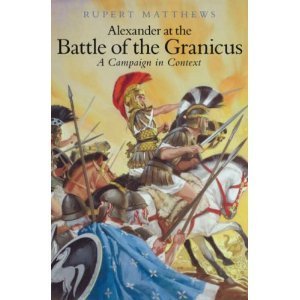
http://www.amazon.co.uk/Alexander-Gre...

The soft twilight of an early summer evening saw the two armies camped on opposite sides of the Granicus River. None of the surviving sources give a very clear account of what happened during those hours of darkness. However, it is fairly easy to reconstruct what passed by looking at what happened the following morning and working back, using comparisons with what happened in similar circumstances on other occasions, to reconstruct the missing events.
The Persian satraps would have been pleased with the events of the first day on the Granicus. The Macedonians had advanced along the road to Cyzicus, as Memnon had correctly predicted they would do. Arriving at the Granicus, they had launched a probing attack with cavalry to test the strength of the Persian defences. That had been thrown back with what seemed to be relatively heavy losses. Now the Macedonians had withdrawn to camp.
So far as the Satraps were concerned, their plan was going exactly to expectations. Alexander had been drawn forward to find his way blocked at a defensive position of the Persians’ choosing. The strength of that position had been shown by the repulse of the cavalry attack that had taken place in late afternoon. The satraps must have been certain that things were going their way. They will have looked forward confidently to the following day when Alexander might renew his assault. No doubt, the satraps thought, any new attack would be driven back decisively.
When dusk fell, the Persian troops would have trailed back to their camp, which seems to have been located fairly close to the river. Persian camps were famously comfortable affairs - it was bad enough being on campaign without being forced to rough it. Certainly the satraps and officers would have had comfortable tents and pavilions with servants, fine foods and entertainments. With a battle due on the morrow, it is unlikely that any of the satraps or senior officers indulged themselves too much. For the soldiers of the royal army there would have been food, tents and servants as well, though not of such high quality.
The bulk of the local militia would not have been so well served. They had to make do with whatever they had brought with them. This might have amounted to not much more than a sack of bread and hard cheese, with a thick blanket for cover. But the night seems to have been a dry and warm one - none of the sources speak of any inclement weather. Diodorus, with his interest in the conditions for the ordinary soldier, would have been bound to mention any rain or cold. No doubt the men were comfortable enough, though they had no luxuries.
from Alexander the Great at the Battle of Granicus: A Campaign in Context [Illustrated] [Hardcover] by Rupert Matthews
Get your copy HERE

http://www.amazon.co.uk/Alexander-Gre...

Published on February 21, 2014 01:10
February 17, 2014
The Battle of Crecy - some of those involved
The Battle of Crecy - some of those involved
Agace, Gobin French peasant from Oiseville who gave the English information regarding the ford at Blanchtaque.
Alencon, Count d’ Charles Valois. Younger brother of King Philip VI and commander of the French rear guard at Crecy.
Amadeus VI Count of Savoy and ally of France. He sent a force of his men to serve with Philip in the Crecy campaign.
Annequin, Godfrey d’ French nobleman. During the Crecy campaign he held the city of Béthune for King Philip.
Artois, Robert d’ 1) Exiled French nobleman serving King Edward III from 1336.2) His father, commander of the French army at the Battle of Courtrai in 1302.
Attewoode, Sir Edward English knight from Staffordshire. During the Crecy campaign he served in the king’s division.
Arundel, Earl of Richard Fitzalan. English nobleman and administrator. He served in the rear guard during the Crecy campaign.
Aubert, Etienne Cardinal Bishop of Ostia. Sent by the Pope to try to broker a peace between Edward and Philip during the Crecy campaign.
Aubigny, Olivier d’ French nobleman. He served on King Philip’s staff during the Crecy campaign.
Aubyn, Robert English gunner. Edward’s royal artillator who both produced gunpowder and handled guns on campaign.
Aufremont Lord d’ French nobleman from near Amiens.
from THE BATTLE OF CRECY by Rupert Matthews
Get your copy HERE
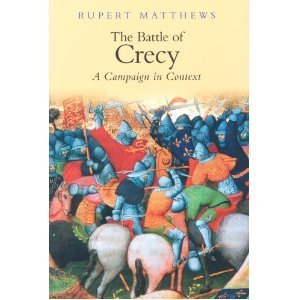
http://www.amazon.co.uk/Battle-Crecy-...

Published on February 17, 2014 00:23
February 13, 2014
Aexander The Great Timeline
Aexander The Great Timeline
356bc Birth of Alexander
336bc Alexander becomes King of Macedon
335bc Alexander destroys Thebes
334bc Battle of the Granicus
333bc Battle of the Issus
332bc Siege of Tyre
331bc Foundation of Alexandria
330bc Battle of Gaugemela
326bc Battle of the Hydaspes
323bc Death of Alexander
from CONQUERORS by Rupert Matthews
Get your copy HERE
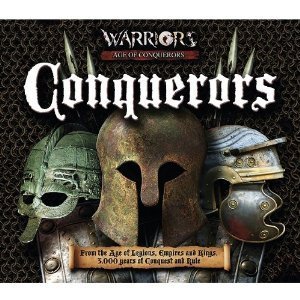 http://www.amazon.co.uk/Conquerors-Tr...
http://www.amazon.co.uk/Conquerors-Tr...

356bc Birth of Alexander
336bc Alexander becomes King of Macedon
335bc Alexander destroys Thebes
334bc Battle of the Granicus
333bc Battle of the Issus
332bc Siege of Tyre
331bc Foundation of Alexandria
330bc Battle of Gaugemela
326bc Battle of the Hydaspes
323bc Death of Alexander
from CONQUERORS by Rupert Matthews
Get your copy HERE
 http://www.amazon.co.uk/Conquerors-Tr...
http://www.amazon.co.uk/Conquerors-Tr...
Published on February 13, 2014 03:54
February 11, 2014
Joe the Navigator
Joe the Navigator
I am glad to say that the RAF never forgot the men of Bomber Command. Many of those who flew the bombers were killed - including one of my mother’s cousins - but others survived. Among those was Joe Wesley, the man who had flown on the Thousand Bomber Raid to Cologne and who I quoted earlier in this book. He was one of the very few men to survive two full tours of duty. I recall meeting him just once when I was a small boy. He was a decorated war hero - having been awarded the Distinguished Flying Cross in 1944 - and a great man in my boyish eyes.
Joe had been a draughtsman in civilian life which gave him some of the skills necessary to be a navigator. My family knew him because he was a school friend of another of my mother’s cousins, Stanley. The pre-war Joe that they had all known was quiet, shy and unpushy in any way. Rather the type who was always passed over for promotion because he was too nice to be the boss. Stanley, himself in the army, once asked an RAF fellow crew member of Joe’s what transformation into a hero came over our family’s shy little chum when he put on his uniform and climbed into a bomber plane. Nobody who knew Joe could picture it at all.
“Well” - came the reply - “everyone wants to fly with Joe as navigator. There can be all hell let loose outside with shells exploding, a sky full of other aircraft or night fighters after you - but Joe sits there with his slide rule and his maps working out where we are and which way we should be going as if he were in an office in the Home Counties. His hands never shake, he never gets panicky. He sits there as cool as a cucumber getting us out there and getting us home.”
So there you are - Joe was one of those people who stay cool in a crisis. What a wonderful gift.
After the war he went back to the draughtsman’s job he had left and sat working quietly away without being ambitious or reaching any great heights of promotion. He had come from obscurity to be a hero and gone back to obscurity when it was done.
He died quite young, as I have noticed in the research for this book did so many who had endured a stressful war. At his funeral I was pleased to see that two young officers were sent to attend on behalf of the RAF. They were only youngsters a little older than me, not even born till after the war, but they turned up impeccably uniformed and circulated amongst everyone at the post funeral reception making polite and suitable conversation. They were a credit to the service.
Joe had not been forgotten.
from RAF BOMBER COMMAND AT WAR by Rupert Matthews
Get your copy HERE

http://www.amazon.co.uk/RAF-Bomber-Co...

Published on February 11, 2014 01:01
February 5, 2014
Visiting the Battlefield of Heavenfield, Northumbria
Visiting the Battlefield of Heavenfield, Northumbria
Distance: 0.5 miles
Terrain: This is a fairly gentle walk over exposed hillsides where the surfaces can be uneven. It is a rewarding walk that explores one of the most important battlefields of Dark Age Britain.
Public Transport: Tyne Valley Coaches route 888 runs from Hexham to Humshaugh, stopping at the crossroads of the A6079 and B6318. From this stop walk half a mile east along the B6318 to join the walk at point 1.
Parking: There is a small layby on the B6318 beside the Battle Monument, where the walk starts and finishes.
Refreshments: There are no shops or pubs along the route of the walk.
from BATTLEFIELD WALKS IN NORTHUMBERLAND by Rupert Matthews
Get your copy HERE
[image error]

Distance: 0.5 miles
Terrain: This is a fairly gentle walk over exposed hillsides where the surfaces can be uneven. It is a rewarding walk that explores one of the most important battlefields of Dark Age Britain.
Public Transport: Tyne Valley Coaches route 888 runs from Hexham to Humshaugh, stopping at the crossroads of the A6079 and B6318. From this stop walk half a mile east along the B6318 to join the walk at point 1.
Parking: There is a small layby on the B6318 beside the Battle Monument, where the walk starts and finishes.
Refreshments: There are no shops or pubs along the route of the walk.
from BATTLEFIELD WALKS IN NORTHUMBERLAND by Rupert Matthews
Get your copy HERE
[image error]

Published on February 05, 2014 01:10
January 29, 2014
The Roman Invasion of Britain begins
The Roman Invasion of Britain begins
In ad43 the Roman emperor Claudius was in need of a success to bolster his rather shaky grip on power, then of only two years duration. When a British king named Verica arrived in Rome to ask for help in regaining the throne of the Atrebates, the tribe that ruled most of what is now Sussex, Claudius saw his chance.
After some preliminary diplomatic moves to ensure the neutrality of the Iceni and Coritani in the British midlands, Claudius ordered the invasion of Britain to proceed. Claudius gave command to the seasoned commander Aulus Plautius, then governor of Pannonia on the Danube. Plautius brought with him the IX Legion Hispania, to which were added the XIV Legion Gemina and the XX Legion Valeria, both from the German frontier. The expedition also included the II Augusta, commanded by the future emperor Vespasian. This gave Plautius around 20,000 legionnaries for his invasion. He also had a number of auxiliary units, though precise details of these have not survived. In all there were probably around 35,000 combat troops, plus a number of support and administrative personnel in the Roman invasion force.
To face the invasion, the Britons had a mixed and divided force. The Cantium tribe, who inhabited Kent, had long standing links to Roman Gaul, but little wish to be ruled by Rome. North of the Thames was a powerful confederation of tribes led by King Caratacus of the Catuvellauni. It had been Caratacus who had ousted Verica and his removal from power was the pretext for the Roman invasion.
Exactly how many men King Caratacus could muster for war it is impossible to say for certain. The Catuvellauni themselves could probably field around 70,000 men, the Cantiaci around 20,000 and the Trinovantes of what is now Essex some 40,000. Undoubtedly other tribal allies could field some thousands of men, and just as certainly it would be impossible to gather all the men together at the same place and time. Cassio Dio, who wrote an account of the campaign, tells us the Romans were outnumbered. What is certain is that the vast majority of the Britons fought on foot. The famous chariots were manned by aristocrats who used them to travel at speed around the battlefield, but who usually dismounted to fight.
from BATTLEFIELD WALKS OF KENT by Rupert Matthews
Buy your copy HERE
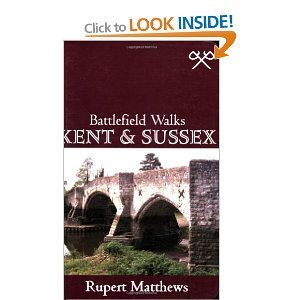 http://www.amazon.co.uk/Battlefield-W...
http://www.amazon.co.uk/Battlefield-W...

In ad43 the Roman emperor Claudius was in need of a success to bolster his rather shaky grip on power, then of only two years duration. When a British king named Verica arrived in Rome to ask for help in regaining the throne of the Atrebates, the tribe that ruled most of what is now Sussex, Claudius saw his chance.
After some preliminary diplomatic moves to ensure the neutrality of the Iceni and Coritani in the British midlands, Claudius ordered the invasion of Britain to proceed. Claudius gave command to the seasoned commander Aulus Plautius, then governor of Pannonia on the Danube. Plautius brought with him the IX Legion Hispania, to which were added the XIV Legion Gemina and the XX Legion Valeria, both from the German frontier. The expedition also included the II Augusta, commanded by the future emperor Vespasian. This gave Plautius around 20,000 legionnaries for his invasion. He also had a number of auxiliary units, though precise details of these have not survived. In all there were probably around 35,000 combat troops, plus a number of support and administrative personnel in the Roman invasion force.
To face the invasion, the Britons had a mixed and divided force. The Cantium tribe, who inhabited Kent, had long standing links to Roman Gaul, but little wish to be ruled by Rome. North of the Thames was a powerful confederation of tribes led by King Caratacus of the Catuvellauni. It had been Caratacus who had ousted Verica and his removal from power was the pretext for the Roman invasion.
Exactly how many men King Caratacus could muster for war it is impossible to say for certain. The Catuvellauni themselves could probably field around 70,000 men, the Cantiaci around 20,000 and the Trinovantes of what is now Essex some 40,000. Undoubtedly other tribal allies could field some thousands of men, and just as certainly it would be impossible to gather all the men together at the same place and time. Cassio Dio, who wrote an account of the campaign, tells us the Romans were outnumbered. What is certain is that the vast majority of the Britons fought on foot. The famous chariots were manned by aristocrats who used them to travel at speed around the battlefield, but who usually dismounted to fight.
from BATTLEFIELD WALKS OF KENT by Rupert Matthews
Buy your copy HERE
 http://www.amazon.co.uk/Battlefield-W...
http://www.amazon.co.uk/Battlefield-W...
Published on January 29, 2014 00:30
January 27, 2014
Slapton Sands Disaster, Devon
The Second World War that broke out in September 1939 had a profound effect on some parts of Devon, but left others untouched. Exeter and Plymouth were both heavily bombed by the Luftwaffe, causing heavy civilian casualties. The naval base at Plymouth came in for particularly heavy bombing, and throughout the war it suffered the dismal sight of ships returning with wounded men on board – or of ships not returning at all.
By the spring of 1944 the worst of the bombing was over, though a few sneak raiders still came over from time to time. Instead the new focus was on the decline of Germany’s military power as her armies lost ground in both Russia and the Mediterranean. It had for months been anticipated that Britain and her allies would seek to invade mainland France from Britain. Vast numbers of men and enormous stores of equipment were being brought into Britain in preparation for the attack that would later become known as D-Day.
A vital part of the preparations was to try out tactics for landing men, artillery and tanks from the sea on to the beaches of Normandy where the invasion would take place. The military planners had been working on their preferred methods for months, but nobody was certain if they would work in practice. What was needed was a practical experiment, and that is where Slapton Sands came into the picture.
The planners wanted to try out their ideas in as realistic a fashion as possible. That meant finding a beach somewhere in Britain that matched the target in France as closely as possible. It needed to be the same size, made up of the same sort of sand and to shelve out to sea at the same gradient. Moreover the area immediately inland needed to mimic that of the invasion beach. Only then could the troops earmarked for the real invasion try out the tactics to see if they would work properly.
Teams of surveyors toured the country’s coast looking for places that exactly matched the strict criteria they had been given, though none of them was told why they had to find beaches of such a precise configuration. Finally a surveyor came to Slapton and found that it was a perfect fit for one of the scenarios he had been given. Unknown to him the match was to the invasion beach codenamed Utah. Not only was the beach identical to that in France but it was backed by a strip of marshy land fed by streams from inland that were of the same sogginess and extent as those behind Utah Beach.
The staff officers planning D-Day were delighted. They set in train the preparatory work for Exercise Tiger, a full-scale pretend invasion that would include not only the first wave of assault infantry and tanks, but also a second wave of support troops landing in numbers on to the established beachhead. The village of Slapton was taken over for military use and all civilians moved out. “To be suddenly evacuated from their homes and means of livelihood at short notice was not a pleasant prospect, wrote Admiral Leatham who was in charge of the operation, “but they took it in good part, realising that their sacrifice was a necessary contribution to the success of the Second Front”.
from
Battlefield Walks: Devon [Paperback]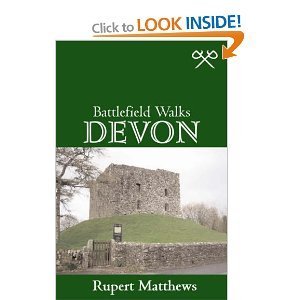 http://www.amazon.co.uk/Battlefield-W...
http://www.amazon.co.uk/Battlefield-W... 
By the spring of 1944 the worst of the bombing was over, though a few sneak raiders still came over from time to time. Instead the new focus was on the decline of Germany’s military power as her armies lost ground in both Russia and the Mediterranean. It had for months been anticipated that Britain and her allies would seek to invade mainland France from Britain. Vast numbers of men and enormous stores of equipment were being brought into Britain in preparation for the attack that would later become known as D-Day.
A vital part of the preparations was to try out tactics for landing men, artillery and tanks from the sea on to the beaches of Normandy where the invasion would take place. The military planners had been working on their preferred methods for months, but nobody was certain if they would work in practice. What was needed was a practical experiment, and that is where Slapton Sands came into the picture.
The planners wanted to try out their ideas in as realistic a fashion as possible. That meant finding a beach somewhere in Britain that matched the target in France as closely as possible. It needed to be the same size, made up of the same sort of sand and to shelve out to sea at the same gradient. Moreover the area immediately inland needed to mimic that of the invasion beach. Only then could the troops earmarked for the real invasion try out the tactics to see if they would work properly.
Teams of surveyors toured the country’s coast looking for places that exactly matched the strict criteria they had been given, though none of them was told why they had to find beaches of such a precise configuration. Finally a surveyor came to Slapton and found that it was a perfect fit for one of the scenarios he had been given. Unknown to him the match was to the invasion beach codenamed Utah. Not only was the beach identical to that in France but it was backed by a strip of marshy land fed by streams from inland that were of the same sogginess and extent as those behind Utah Beach.
The staff officers planning D-Day were delighted. They set in train the preparatory work for Exercise Tiger, a full-scale pretend invasion that would include not only the first wave of assault infantry and tanks, but also a second wave of support troops landing in numbers on to the established beachhead. The village of Slapton was taken over for military use and all civilians moved out. “To be suddenly evacuated from their homes and means of livelihood at short notice was not a pleasant prospect, wrote Admiral Leatham who was in charge of the operation, “but they took it in good part, realising that their sacrifice was a necessary contribution to the success of the Second Front”.
from
Battlefield Walks: Devon [Paperback]
 http://www.amazon.co.uk/Battlefield-W...
http://www.amazon.co.uk/Battlefield-W... 
Published on January 27, 2014 06:43



